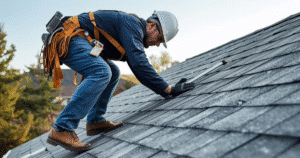• Step-by-step guide to roofing a house, including material selection and measuring tips
• Common DIY roofing mistakes to avoid for a flawless installation
• Conclusion highlights the importance of professional help for roofing projects
Recognizing the Warning Signs
Your home’s roof is its first line of defense against the elements, and it’s crucial to recognize when it’s falling short of its protective duties. If you find shingles littering your yard after a storm, it’s a telltale sign of wear and the need for closer inspection. Similarly, water stains on ceilings or walls indicate a breach in your roof that requires immediate attention. Even without leaks, an aging roof may display curled, cracked, or missing shingles, pointing towards the inevitable need for a repair or replacement.
Preventive checks can save you from larger issues down the line. Regularly assess your roof from the ground with binoculars, looking for areas where shingles are uneven or lifting, as these can be entry points for water. Inside your attic, monitor for daylight streaming in or a sagging roof deck—both are indicators of a structural concern. Finally, excessive energy bills can hint at inadequate roof ventilation or insulation, which compromises your roof’s efficiency and your home’s overall energy consumption.
When contemplating how to roof a house, the initiative starts long before purchasing materials or climbing a ladder. Understanding that minor issues can escalate quickly will prompt decisive action to address roofing problems. A comprehensive inspection from a certified professional can provide a clear picture of your roof’s condition. This will inform the necessity of the upcoming steps, determining whether it’s time for a minor fix or a complete overhaul.
Preparing for a Roofing Overhaul
As you prepare to undergo the roofing process, remember that a little preparation can prevent future headaches. Documenting the state of your roof with photos can serve as a reference point and potentially assist in any insurance claims. Establishing a clear workspace around your home’s perimeter ensures safety and efficiency during the project. And lastly, be mentally prepared for the sound and presence of work being conducted, as roofing can be a loud and invasive process.
Starting Your Roofing Journey
Embarking on a roofing project begins with key choices that can make or break the success of your endeavor. Selecting the right roofing materials is not just a matter of style but also a reflection of your commitment to durability and climate suitability. Costs vary widely, so setting a budget beforehand helps navigate the vast selection without compromising on quality. With materials like asphalt shingles for affordability and ease or metal for longevity and energy efficiency, the options are vast but choosing wisely ensures your roof stands the test of time and weather.
Once you’ve chosen your materials, the next step is to measure your roof accurately to estimate how much material you’ll need. Roofing isn’t a one-size-fits-all solution; every house has its unique dimensions that must be considered to avoid shortages or excess. Adding 10% for waste and unexpected adjustments will buffer against the inevitable surprises that come with home improvement projects. This careful planning is a cornerstone of Ecobuild Roofing’s residential services, ensuring projects meet clients’ needs precisely.
Ensuring a Strong Foundation
With measurements in hand and materials selected, preparing the actual site becomes your focus. Stripping away old roofing may uncover hidden issues with the roof deck—issues that must be addressed before proceeding. Rotted wood or prior improper installations can be red flags for potential future problems. It’s critical at this stage to repair any damage and lay a solid foundation for the new materials, because a strong roof begins with a solid deck.
The process can be complex, but with the right preparation and professional guidance, even the most daunting tasks become manageable. Properly disposing of old materials not only clears the way for your new roof but also adheres to environmental standards. Inspecting and repairing the roof deck creates the optimal conditions for installation. It’s this level of attention to detail that distinguishes a quality roofing job from a temporary fix, setting the stage for years of reliable protection for your home.
Step 1: Choose the Right Roofing Materials
Before starting your roofing project, select materials that suit your climate and house style. Consider durability, cost, and installation requirements.
Step 2: Measure Your Roof
Determine the area of your roof to estimate how much material you’ll need. Measure the length and width of each plane on the roof, then multiply for the area and add 10% for waste.
Step 3: Remove Old Roofing
If re-roofing, carefully strip away old shingles or roofing materials. Dispose of them properly and inspect the roof deck for damage.
Step 4: Repair and Prepare the Roof Deck
Ensure the roof deck is solid, replacing any rotted wood. Apply roofing felt for extra protection against water penetration.
Step 5: Install Drip Edges and Flashing
Secure drip edges along the roof’s perimeter to guide water away from the fascia. Add flashing around vents, chimneys, and other penetrations to prevent leaks.
Step 6: Lay down Roofing Material
Starting from the bottom edge, lay your chosen roofing material. Use proper techniques to secure shingles or panels, ensuring each row overlaps the one below.
Step 7: Finish with Ridge Caps
Cover the peak of your roof with ridge cap shingles to provide an extra layer of protection and to give your roof a finished look.
Step 8: Conduct a Quality Check
Inspect your work for any missed spots or potential weaknesses. Make any necessary corrections and ensure everything is sealed and secure.
Avoiding Common Roofing Mistakes
Taking on a roofing project can be a formidable task, and even with careful planning, it’s easy to fall into common pitfalls. These mistakes can lead to bigger issues down the line, costing more time and money to rectify. An understanding of these errors and how they occur is the best defense against inadvertently compromising your new roof’s integrity.
- Mistake 1: Underestimating Material Needs
It’s tempting to save money by purchasing just enough materials to cover your roof’s square footage. However, this often results in shortages, particularly when accounting for mistakes or damaged pieces. To prevent this, always add at least 10% to your estimated material needs to ensure you have enough to complete the job. - Mistake 2: Ignoring the Manufacturer’s Instructions
Every roofing material has specific installation instructions that are crucial for warranty and performance. Skipping these guidelines can lead to improper installation, resulting in leaks or reduced lifespan of your roof. Always consult and follow the manufacturer’s instructions for the best results. - Mistake 3: Neglecting Safety Precautions
Roofing can be dangerous, and neglecting safety gear or safe work practices puts you at risk of injury. Ensure you’re using proper footwear, safety harnesses, and are aware of your surroundings at all times on the roof. Safety should always be your top priority. - Mistake 4: Poor Flashing Installation
Flashing is vital for preventing water from entering at the roof’s joints, yet it’s commonly overlooked or rushed. Improper installation can cause significant water damage over time. Take care to install flashing according to guidelines, ensuring it’s sealed and positioned correctly. - Mistake 5: Overlooking Ventilation
Adequate roof ventilation is essential to control moisture and temperature in the attic. Failure to provide proper ventilation can lead to mold growth and compromise the entire roof system. Ensure your design includes appropriate venting solutions to maintain the longevity of your roof. - Mistake 6: Misaligning Shingles
A straight shingle line is critical for roof aesthetics and function. Misalignment can cause water infiltration and diminish the roof’s appearance. Use a chalk line to ensure straight rows and avoid this common error. - Mistake 7: Rushing the Process
Rushing through a roofing project can lead to cutting corners and mistakes. Take your time with each step, double-check your work, and don’t rush—your roof’s lifespan depends on it.
Perfecting the Roofing Craft
After ensuring a sturdy roof deck, it’s time to focus on moisture management by installing drip edges and flashing. Drip edges guide rainwater away from the fascia, preventing water damage and preserving the structure of your home. Flashing is just as crucial, as it seals the joints around chimneys, vents, and skylights against water intrusion, securing the weak points that are most susceptible to leaks.
These components are essential for a long-lasting roof, and when installed correctly, they save homeowners from future costly repairs. You can learn more about the importance of these features and how they contribute to the overall health of your roofing system by visiting Ecobuild Roofing’s residential roofing services. Taking the extra steps now ensures your roof is built to last, providing security and peace of mind through every storm and sunny day alike.
Securing Your Home’s Top Layer
The central task in roofing is the proper placement and fastening of your chosen roofing material. Whether using traditional asphalt shingles or more modern alternatives, the key is to begin from the bottom edge and work upward, overlapping each row for complete coverage. This methodical process not only secures each piece into place but guarantees that water runs off the roof effectively, avoiding any potential leaks.
Completing your roof with ridge caps adds an extra layer of protection and creates a clean, finished look for your home. Not to be overlooked, this final touch seals the peak of your roof and prevents wind-driven rain from penetrating the roof’s highest points. As each step builds on the previous, these finishing details encapsulate the combined efforts that result in a resilient and robust roofing system.







